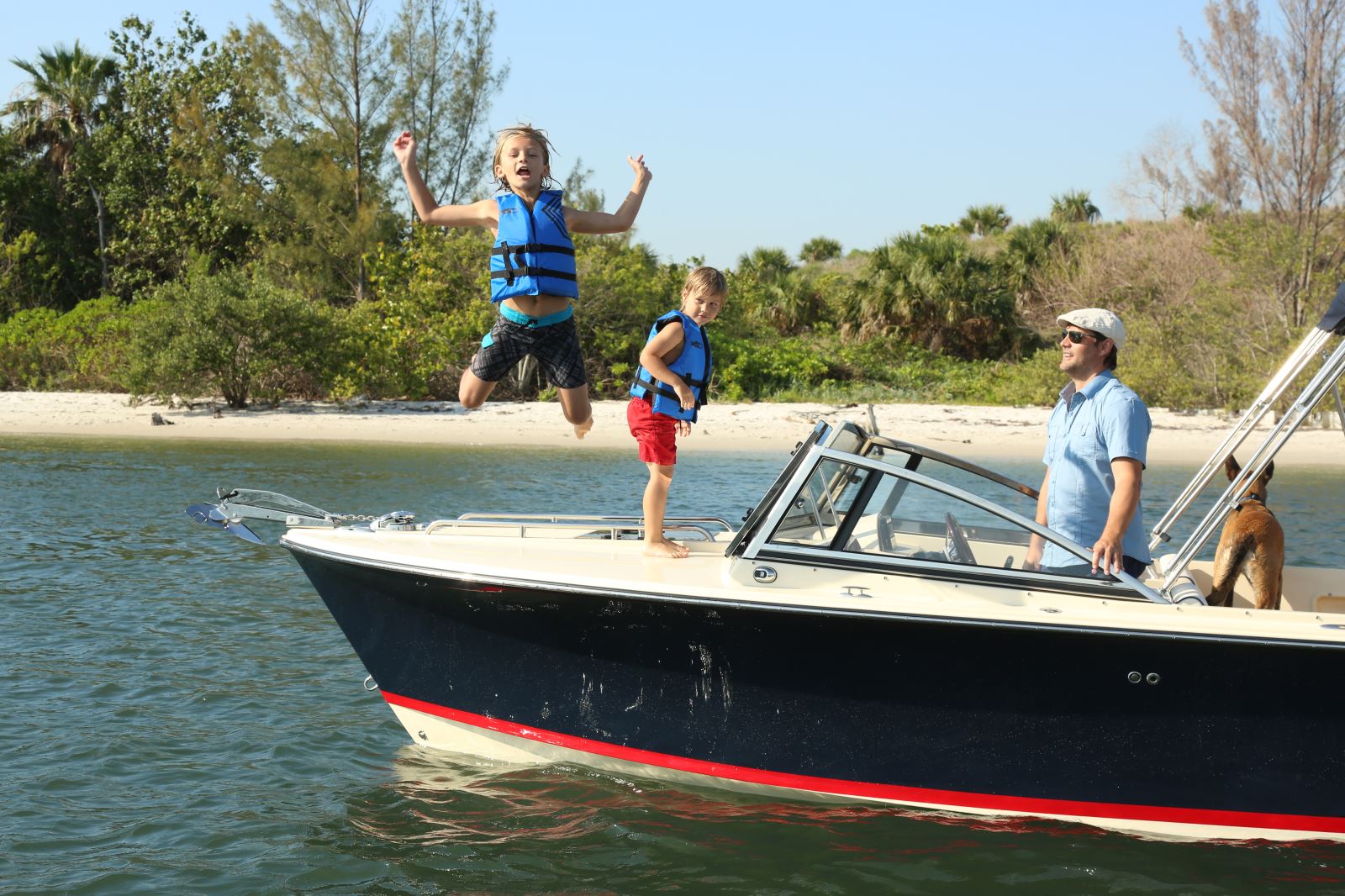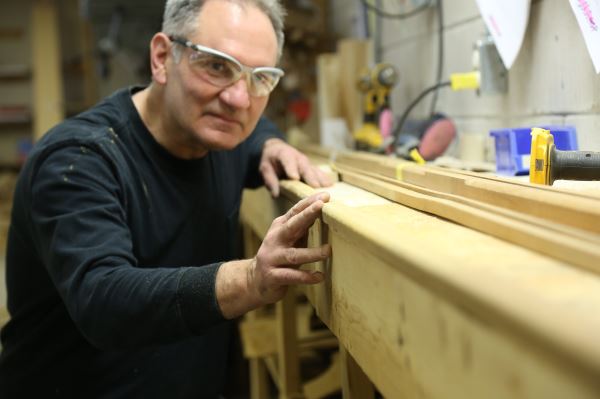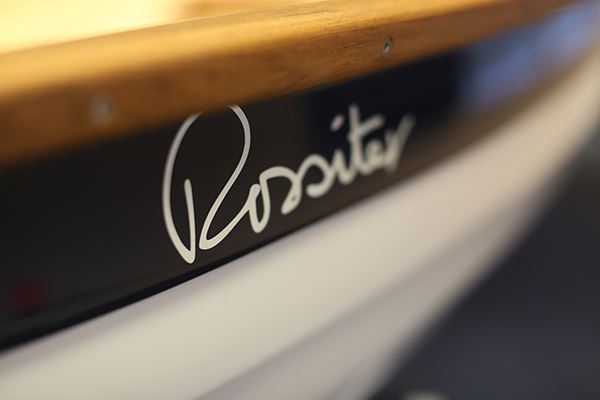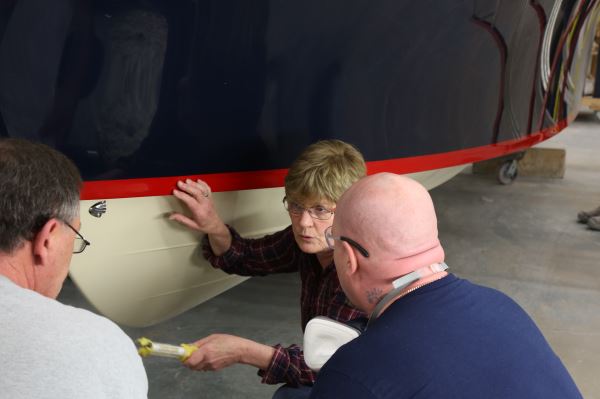
“As much as I love to build the odd piece of furniture, it’s still an inanimate object. There’s something about a boat that’s much more. Every time I get in it, it’s different. Different than pulling out the drawer on that piece of furniture. A boat is a living, breathing thing that you create and it allows you make memories that last forever. When customers come and talk about their Rossiter, they talk about their memories more than the boat itself. It resonates with me because that’s what interested me about boat building in the first place.”
Scott Hanson, President and CEO of Rossiter Boats, is a patient man. A graduate of the Landing School in Maine, Scott learned the art of boat building with pencils, graph paper, and serious mathematics and would even train under George Rossiter in his woodshop for 18 months before taking the helm. He is not in a rush to make the next dollar. That’s exactly the person who turns a wooden row boat company into a major player in power boats, seeing 20 percent yearly growth today.
Growing up in Toronto with summers in Georgian Bay, Scott was a self-proclaimed river rat and the entrepreneurial bug bit early. At age 15, Scott wrote to Windsurfing International in California requesting product and sponsorship for a lakeside shop. He ran the shop successfully, developing relationships across a small segment of the marine industry, for the remainder of his high school years. Post-graduation, Scott went straight into the high-flying corporate life, working for a large, multinational advertising firm based in the United Kingdom. He specialized in packaged goods and financial marketing, eventually onto Toronto Dominion Bank’s corporate marketing division.
“I never got the love of boating and the marine industry out of my blood,” Scott recounts. “In 1993, I convinced my wife of 28 years to go take a tour of New England and look at boat building schools. I still had this thing inside me that said: I still want to get involved in the marine industry. So, we traveled from The Maritimes here in Canada down through Maine and all the way down to Virginia. I was quite taken by the Landing School in Maine. I love working with my hands and wanted to learn that aspect of boat building before I went onto learn the engineering side.”
Unfortunately, upon graduation the number of marine jobs were few and far between so Scott returned to his roots in marketing. He started and grew The Rutter Group, which was focused on marketing communications. He sold the firm to a larger organization and became CEO of a market research firm, which took care of consumer marketing for everything from repositioning the United States after September 11th to clients like Proctor and Gamble and General Motors.
With success comes responsibility, and 80-hour work weeks. One week, Scott found himself on the third leg of a transcontinental flight having already crossed North America once. He woke up in a hotel in San Francisco, jet-lagged and not quite sure which city he was in or the last time he’d seen his children. Scott knew something had to give.
“My children would look in the sky, see an airplane and say: well, there’s dad’s office. In 2006, I was traveling a tremendous amount. The week before I’d flown from San Francisco to Toronto, had just enough time on the ground to read my children a bedtime story because I hadn’t seen them in a long time. The next morning I had to be in New York, and then back to San Francisco the next day. I woke up in the middle of the night and I really didn’t know where I was. On the overnight from there to New York, I collected my thoughts and wrote a letter to myself:
Scott, your boys are growing up. You’re losing my connections with the woman you married years ago because I’m not part of that experience any more. You need to make a resolution to reconnect. Whether that reconnection means backing away from work or finding something new and different. Either way, you need to be a part of your family and the life you’ve created.”
A couple months into 2006, after letting a few friends know he was looking for a change, Scott and his wife bumped into George Rossiter at a cocktail party. George approached him and said, “Scott I understand you’re tired of airplanes and you’re thinking of potentially pursuing something in this area. As you know, I’m battling cancer and I’ve been told to look for a future for Rossiter Boats.” The two began an 18-month transition that would change both their lives for the better.

Through the Recession
“Waking up in 2008 as the world was unfolding before our eyes, I wondered what I had done. I would go into the wood shop in the morning, and as much as I love listening to public radio I had to turn it off. I just didn’t want to hear it. I had to stay positive.”
While the world faced the most challenging time since the Great Depression, Scott drew on his past experiences as if he was prepared all along for this precise moment. His time at Toronto Dominion happened to be during the recession of the late 1980s, and he was asked to complete a study of the Great Depression. The outcome would be to determine what various companies in a variety of categories -- automotive, insurance, banking, packaged goods -- did to survive the Depression? What changes did they make? And what happened to those companies post-Depression?
“I looked at that and said to myself: Ok, Scott. There will be a time where consumer confidence comes back. The question is when and how long? And what should we do in the meantime?”
Scott observed that Rossiter Boats would not grow by building one row boat at a time. He took the time to understand what makes the distribution chain work in terms of dealers. He asked - even though dealers were in financial paralysis at the time - what they would like to see from a boat company that they were not already getting? Then he listened. A plan emerged and Rossiter Boats has been executing on that plan ever since.
“We were going to leverage the love people had for the Rossiter 14 side-console and look to design and engineer bigger boats. I didn’t want to be all things to all people, though, so we would focus on building great small boats in terms of performance and quality. We wouldn’t abandon George’s vision of quality. I took the time to articulate what the essence of the brand was, took the time to build distribution in New England and Florida to take that seasonality out of our business. Took the time to build distribution here at home, on the Great Lakes, and prepare ourselves for when things improved.”
“I think that’s probably - as it’s turned out - a good strategy. Was it scary? Yes, we invested everything we had personally and from a family perspective. But the market wanted big water performance in something small, more efficient, and with a timeless design. And that’s what we intended to give them.”

One Leaflet at a Time
“We sold the future of Rossiter on a poster and a leaflet in January that year at the Toronto Boat Show, and we put our first 17-footer in the water July 1st that year. That was met with great success! We had a number of orders immediately for the next year and we went into full production. At the time we were working out of an industrial quonset hut and a two car garage, but we knew we needed to be producing the 17-footer under one roof. So I rented a 14,000 square foot facility and we thought we’d died and gone to heaven.”
Scott hired more full-time employees and they were working through the entire year. The dealer distribution in New England and Florida was off the ground, but Rossiter was still a three-model power boat company. Their success lead dealers and customers to ask: what’s next? Where were the boats that allowed whole family can go out and have a good time on the Great Lakes together?
Scott took a look at the growing business and an economy which was finally turning around, and began sketching out Rossiter’s 23-foot Classic Day Boat. He brought in engineers from New England who took the ideas into the world of 3D modeling and tooling to make sure the designs would float all compliance inspections. The boats were then tooled by Vector Works in Florida and more recently Marine Concepts.
Bringing the Classic Day Boat into production caught the attention of industry media and Rossiter Boats started seeing the light at the end of the proverbial tunnel. With a proven track record of listening to the market and delivering on promises, dealers and customers alike now trusted Scott and Rossiter implicitly. Within the year, people were happy with the ride and the layout of 23-footer but started asking Scott about a trailerable version.
Laughing, Scott recounts this moment: “But a 20-footer, trailerable boat--they said-- would be perfect. How would you like to design that, Scott? So the dealers and consumers alike convinced us to build a 20-footer. With the help of our engineers and designers at Fast Forward design, we conceived the 20. And we did the same thing again!”

The design was conceived and refined over the course of 12 months, and received positive feedback by Rossiter’s Dealer Council. With more confidence, Scott put the wheels in motion on production of this 20-footer earlier than 23 and certainly the 17, but still took only posters and leaflets to the boat shows. From shows on the Great Lakes alone, Rossiter sold out production on the 20 for 18 months, just based on the concept. The 20-foot Coastal Cruiser made its debut in the water in April 2017.
“I’m proud as an individual to personally have had the opportunity to celebrate George Rossiter’s vision and tradition of timeless design and elegance and unexpected performance in terms of choice of materials and how we do what we do. So be able to build on that vision of George Rossiter’s and have the company be what it is today, thanks to 40 full-time employees. Is it challenging? You bet. Was it a rocky ride through the Recession? Absolutely. Is the challenge of managing 20% growth every year daunting? Yes it is. We’ve built our reputation on quality and performance and it would be very shortsighted to veer away from that, no matter the allure of the all mighty dollar.”
Rossiter Boats
www.rossiterboats.com

